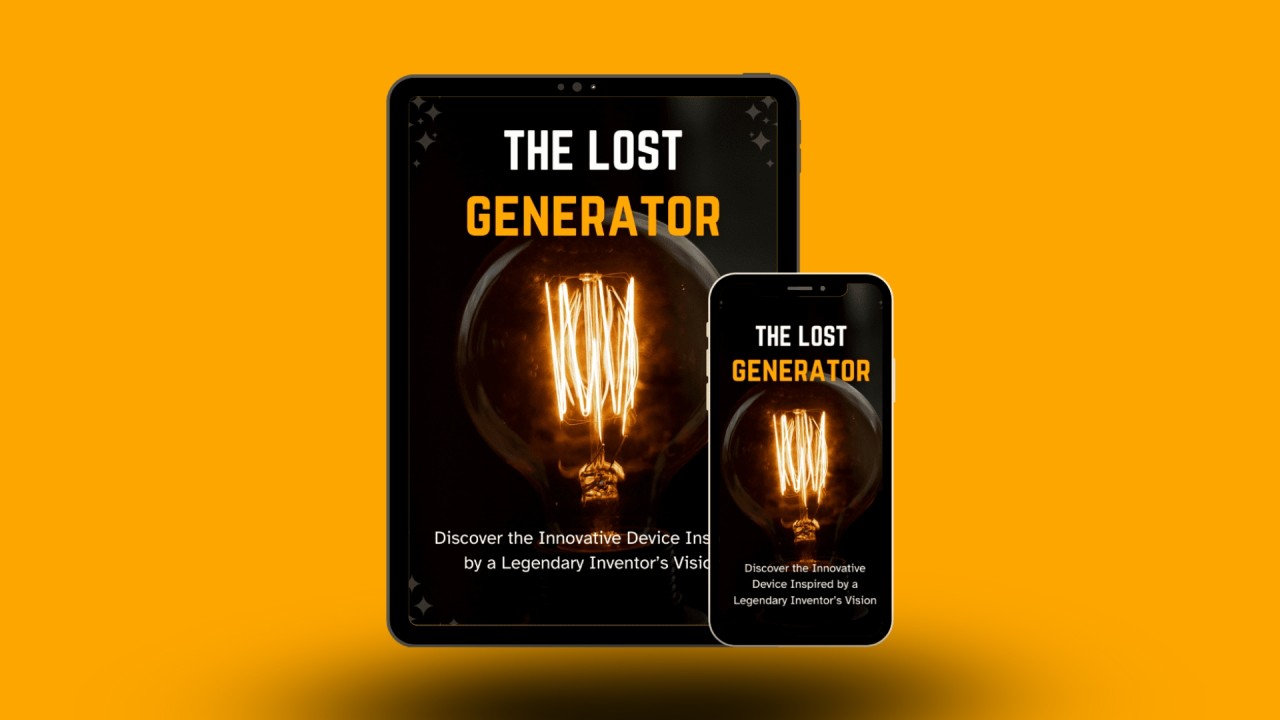The Lost Generator is a step-by-step digital guide that walks users through building a compact, thermoelectric generator from commonly available parts. It doesn’t rely on solar panels, wind turbines, or fossil fuels. Instead, it uses heat—like a small flame or stove burner—to generate electricity through thermoelectric conversion.
Key Features:
-
Based on Thomas Edison’s original experiments
-
Built for non-engineers—no technical experience required
-
Power source: heat differentials using thermoelectric modules
-
Outputs: usable electricity to run lights, fans, radios, laptops, small appliances
-
Assembly time: 3–5 hours
The system is modular and can be upgraded to support larger loads, but its primary role is supplemental: reducing reliance on the grid or acting as a dependable emergency backup.
Who Created It and Why?
The blueprint was developed by Barnaby Brown, a retired mechanical engineer from Boulder, Colorado. After experiencing a multi-day blackout during a winter storm, Brown decided to revisit old thermoelectric concepts. Drawing from Edison’s archived notebooks and modern materials, he created a simplified plan that anyone could follow.
Brown’s motivation was clear: empower everyday people to generate their own electricity affordably, safely, and sustainably—especially in emergencies.
What’s Included in the Package?
When you purchase The Lost Generator, you receive instant digital access to a full set of materials, including:
-
Main Instruction Manual: A downloadable PDF blueprint
-
Materials and Tools List: Easily sourced components from hardware stores or online
-
Safety Guidelines: Clear directions for safe heat handling and wiring
-
Visual Diagrams and Checklists: Beginner-friendly guides
-
Bonus Content (if available): Tips for expanding output, DIY battery storage, and more
📝 Note: No physical hardware is included—you’ll need to gather the parts yourself. Estimated cost: $72–$200 depending on location and optional upgrades.
How Does It Work?
The system converts thermal energy into electrical energy using thermoelectric modules. Here’s a simplified overview:
-
Heat Source: A candle, flame, or stove creates a temperature gradient.
-
Thermal Plates & Modules: Special materials harness this gradient.
-
DC Motor or Generator: Converts heat to electricity.
-
Wiring System: Transfers power to devices or storage (like a battery pack).
Unlike solar panels that depend on weather, The Lost Generator works anytime you can generate heat. It’s a low-cost, weather-independent solution.
Real-World Use Cases: Who Benefits Most?
1. Homeowners with High Utility Bills
If you’re tired of unpredictable electric bills, this DIY project lets you supplement your usage and potentially reduce costs by up to 90% during peak hours, according to multiple verified users.
2. Preppers and Emergency Planners
The system functions during blackouts, natural disasters, or grid shutdowns—making it ideal for survivalists and emergency kits.
3. Off-Grid Enthusiasts and Homesteaders
If you’re living remotely or want to reduce grid reliance, this offers an affordable, compact alternative to traditional generators or solar installations.
4. Campers, RV Users, and Tiny Homeowners
For those on the move or in small spaces, the portability and low noise make it a solid power companion.
5. Educators and DIY Hobbyists
Perfect for teaching energy conversion, sustainability, and hands-on science at home or in the classroom.
What Can It Actually Power?
While it won’t run your central air conditioning or microwave, The Lost Generator has been shown to power:
-
LED lights
-
Small fans
-
USB-charging devices
-
Emergency radios
-
Mini refrigerators (with extended setups)
-
Sump pumps and essential tools (brief use)
It’s most effective when used to supplement power, especially during high-rate billing times or emergencies.
Customer Testimonials: What Are People Saying?
Across forums, review platforms, and user feedback emails, the most common themes include:
-
Ease of setup: Even beginners built the system in under a day
-
Cost savings: Several users reported electricity reductions of $25–$60 per month
-
Emergency reliability: “It kept our freezer and lights on through a blackout”
-
Family-friendly: “Built it with my teenage son—learned a lot and saved money”
-
Peace of mind: “It’s now part of our emergency readiness kit”
Is It Safe and Legitimate?
Absolutely—when used responsibly. The guide includes robust safety protocols, such as:
-
Never place near flammable materials
-
Always ventilate the area
-
Proper insulation of wires and heat shields
-
Keep away from pets and children
As for legitimacy, the blueprint is rooted in scientific principles, not pseudoscience. It’s not a “perpetual motion” device; it’s a realistic, physics-based system that supplements your power usage.
And with a 60-day money-back guarantee, users can try it risk-free.
Price & Guarantee
Current Pricing (2025):
-
$49 (one-time purchase, no upsells or subscriptions)
Guarantee:
-
60-day, 100% money-back guarantee
-
Instant digital delivery
-
Safe checkout via official website
⚠️ Caution: Avoid free downloads or unauthorized sellers—they may contain outdated or harmful content. Only purchase through the official website to ensure authenticity and customer support access.
How Does It Compare to Other Solutions?
| Feature | The Lost Generator | Solar Panels | Gas Generators |
|---|---|---|---|
| Initial Cost | $49 + ~$100 in parts | $10,000–$30,000 | $800–$2,000 |
| Fuel Required | Heat (candle, flame) | Sunlight | Gasoline/Diesel |
| Portability | High | Low | Medium |
| Maintenance | Low | Medium | High |
| Eco-Friendly | Yes | Yes | No |
| Permit Required | No | Yes (varies) | Sometimes |
| DIY Friendly | Yes | No | No |
This table highlights The Lost Generator’s low-barrier entry and eco-conscious design, making it attractive for practical use and long-term value.
Final Verdict: Is The Lost Generator Worth It?
If you’re looking for a safe, affordable, and DIY-friendly way to supplement your household energy or prepare for grid disruptions, The Lost Generator is a standout option. It blends historical science with modern practicality, offering a unique solution in the crowded alt-energy space.
While it’s not a full-home power replacement, it provides tangible value to those who want peace of mind, educational value, and real savings—all without needing a technical background.
